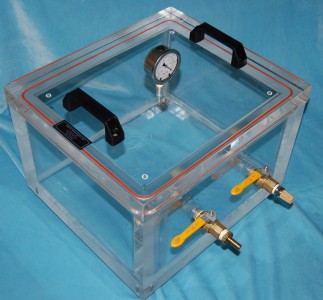Operators of vacuum systems sometimes require a 360 ° view of the Unit Under Test (UUT). This is especially true of many packaging leak tests. Abbess Systems has a wide portfolio of high-visibility systems to suit your needs.
Do you need to see your products while they are under vacuum? Observe filling and encapsulation operations and leak test your medical, pharmaceutical, food, electronics, and aerospace inventory and packaging with Abbess Instruments’ High-Visibility Vacuum Systems. Satisfy Quality Control requirements by automatically monitoring, data-logging, and displaying the vacuum environment.
Do you need to submerse your product in a liquid? Some leak tests call for submersing packaging in a liquid – then looking for bubble streams. High-Visibility chambers are ideal for this, and Abbess chambers can accommodate such “wet” testing, including by using stainless steel fittings. Abbess can provide hold down fixtures to keep your product immersed while still providing visibility of bubble streams. Abbess chambers are compliant with ASTM D4991-07.
Do you want easy operation? Chambers may be upgraded with drains and/or spill trays to handle spills or easy emptying of wet test chambers. Also, fittings can be installed near the top of the chamber for easy liquid fill of wet chambers.
Do you require manual or automatic operation? Abbess will work with you to customize the automation to your process, just as we will work with you to ensure the system configuration meets your production needs:
While the most basic system can be controlled manually (by starting/stopping the pump(s) and opening/closing valves), a Vacuum Cycle Controller (VCC) can be added to automate a) vacuum/hold/vent control functions, and b) vacuum (and thermal) monitoring. Control may be either via panel-mounted buttons and indicators or via a PC with user-specified Graphical User Interface (GUI). The basic digital VCC will permit a single ‘automatic’ altitude/vacuum set point, whereas full altitude profile simulation functionality can be built in to the PC Touch Screen VCC upgrade option. Emergency or non-automated vacuum venting can be always readily achieved with the manual vent valves.
Features? The High-Visibility Vacuum System consists of the following:
- Vacuum Chamber – A front or top-loading Acrylic Cylinder or Cube with or without an aluminum frame and/or base (as in Figs 1-7). Such chambers can be designed to reach 10-4 Torr. Most High-Visibility Vacuum applications are in the 60 to 10-3 Torr range.
- Vacuum Pump- Provided with Inlet and Exhaust filters. Power and automatic control can be integrated into a Vacuum Cycle Controller (VCC).
- Altitude Profile Simulation — This requires upgrading to a VCC.
- Process Control Enclosure – Contains components necessary for controlling the system as well as logic and interfaces for the Vacuum Cycle Controller.
- Process Timer Control
- Status Indicators – Provide visual indication of system status.
- Vacuum Cycle Controller – Control ON/OFF buttons, main power switch.
- Pressure Gauge
- Pressure Transducer/ Gauge Controller – Provides pressure display and set point valve control per integral Pressure Transducer data. Also provides pressure set-point relays that can be used for various system control functions.
- Control Valves
Automatic Vent Valve – Automatic solenoid valve vents air or inert gas purge into chamber based on control input from Vacuum Cycle Controller.
Do you have limited Counter Space, or large batch sizes?
The entire system can be integrated on a cart using identical or mixed-sized, cylinders. Since cart mounted systems are shipped turn-key, set-up is minimal. Cart-mounting provides full system mobility and thus flexibility of positioning on your production floor. Recessing vertical cylinders into the cart provides improved ergonomics of loading/unloading top loading chambers.
Do you require any options? High-Visibility Vacuum System upgrade options include:
- A Vacuum Cycle Controller (VCC) that can be used to automate some or all of the control functions via panel-mounted buttons and indicators (illustrated in Fig 2). It will permit a single ‘automatic’ altitude/vacuum set point.
- A VCC controlled by a PC with a user-specified Graphical User Interface (GUI) operated through a touch-screen. This permits: automatic monitoring, data-logging, and vacuum environment display; remote access; and message-sending to operator’s mobile device.
- Altitude profile simulation functionality can be built in to the PC Touch Screen VCC upgrade option.
- Mobile cart (Figs 2 & 7).
- Shelving (passive) (Fig 6).
- Inert gas purge.
- Mechanical feedthroughs such as shafts with or without rotation.
- Optical ports for optimal transmission of test equipment wavelengths (e.g. UV (Fig 7), IR).
- Hold down fixture (often required to keep empty packaging submersed under liquid, illustrated in Fig 2).
- Drains, and/or spill trays.
- Aluminum frames (Fig 1) are required for high-visibility 18” and 24” cubes. These chambers are rated for 10-4 Torr.
- Aluminum bases (Fig 3) provide for easier set-up, and for customizing with feedthroughs (especially electrical).
Are you concerned about craftsmanship? Abbess Instruments’ vacuum chambers are vacuum tested to 10-4 Torr and will maintain this for as long as the customer performs proper maintenance on the chamber. Chamber maintenance simply requires regular cleaning and the occasional changeout of the seal (available through Abbess). Abbess Instruments systems are delivered with industry-leading lead times.
Abbess can help you. Successfully test your high-value inventory in our manual or automatic, data-logged or not, single or multi-chambered, dry or wet, High-Visibility Vacuum systems.








